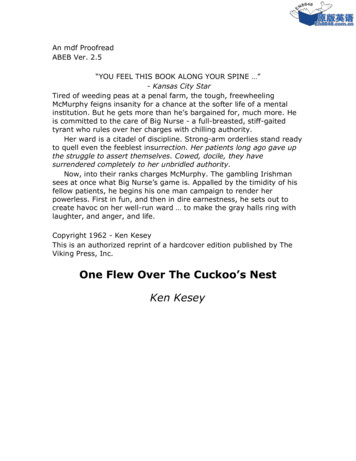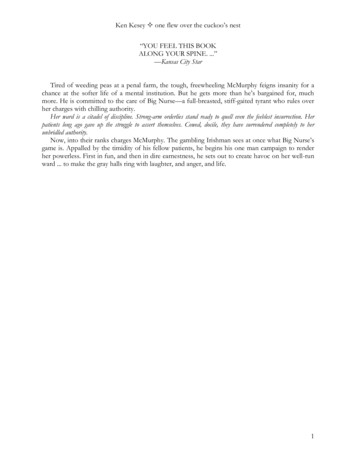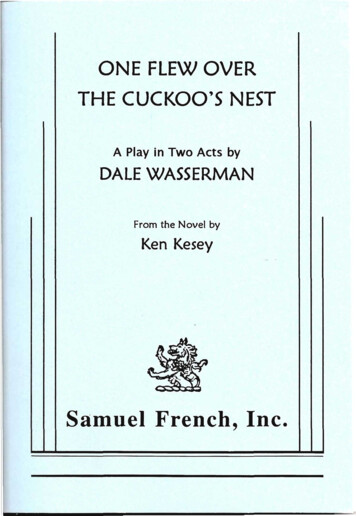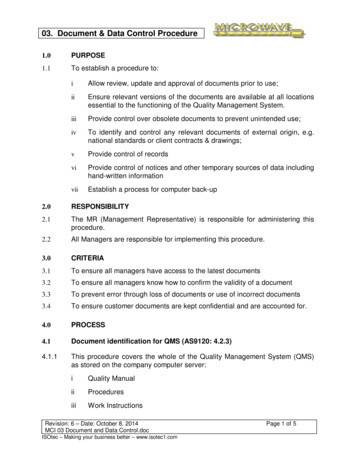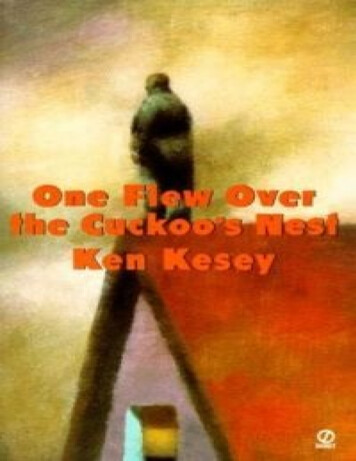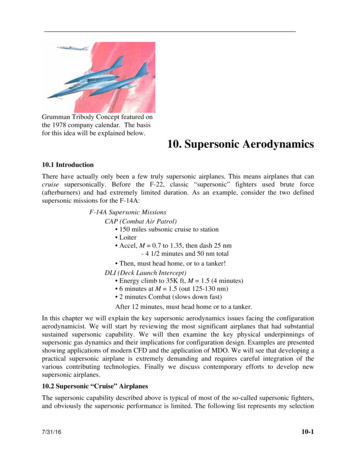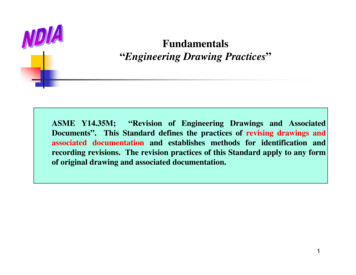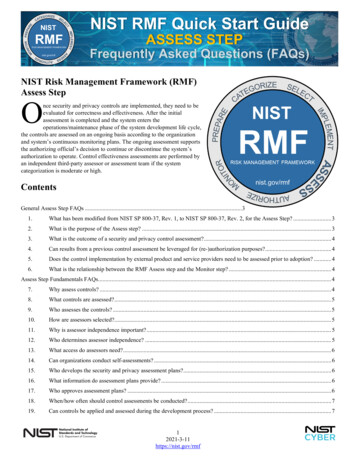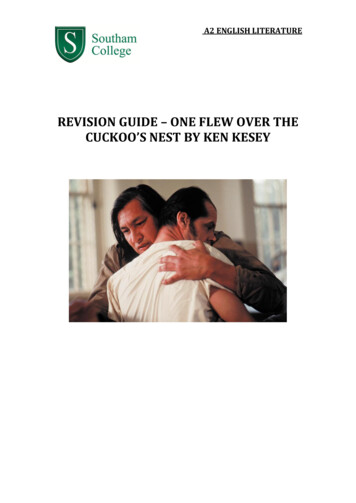
Transcription
A2 ENGLISH LITERATUREREVISION GUIDE – ONE FLEW OVER THECUCKOO’S NEST BY KEN KESEY
Character AnalysisRandle P. McMurphyMcMurphy is a charming and handsome man, with long red sideburns and a tangle of curls. He is"broad across the jaw and shoulders and chest" and is tall. He also has a "devilish grin" and avoice that is "loud and full of hell". He is used to having his own way and is a natural leader. Hetells the patients that he is used to being "top man" and quickly assumes that role.McMurphy is a gambling Irishman and convict, who grows tired of labouring at the Pendletonprison farm. To escape prison life, he feigns insanity and gets himself involuntarily committed toa mental hospital in Oregon. He tries to bring about a change at the hospital, for he does not likethe fact that grown men act like "rabbits" and are scared of the Big Nurse. He tries as hard as hecan to "get her goat", by not doing the duties he is given. He even disrupts her group therapysessions by hogging the limelight.McMurphy is also a sly creature. When he learns that an involuntarily committed patient cannotget out of the hospital unless the Big Nurse thinks the patient is fit enough to leave, he backsdown and tries to be a model patient. By this time, however, the patients have come to rely on hisleadership, so much so that Cheswick, one of his most ardent followers, drowns himself out ofdespair. McMurphy has a change of heart after he learns that most of the patients havevoluntarily committed themselves and stay out of choice. He decides he must become theirsaviour and show them they can function outside the hospital. He makes his comeback statementby smashing the glass of the Nurse's station. Thereafter, McMurphy slowly becomes a force thatis driven not by this own will but by the needs of forty other patients.McMurphy takes the back seat on the fishing trip, letting others brave the storm and emerge asheroes in order to gain courage and self-reliance. When the Nurse tries to drive a wedge betweenthe patients and him, he proves himself by coming to the aid of George, fighting the Blackorderlies. This aggression lands him in the shock shop for several treatments. When he isreturned to the ward, he continues to try and make the inmates self-sufficient. He proves to themthat Nurse Ratched is really powerless when he tears open her shirt and exposes her largebreasts. She retaliates by having him lobotomized. When he is returned to the ward after thesurgery, he is a vegetable.It is important to notice how McMurphy steadily becomes weaker as the other patients becomestronger. He serves as a tool in bringing freedom to the other mental patients and in exposing theNurse for what she really is. As a result, McMurphy stands for all that is good and natural; heopposes Nurse Ratched, who is the symbol of repression and evil. Although his fool-hardy andself- damaging acts liberate the others, he is destroyed in the end. In this sense McMurphy iscompared to Christ, who lays down his own life so that others may live. When Chief Bromdenkills him and escapes, McMurphy's mission is accomplished.Randle Patrick McMurphy IIRandle Patrick McMurphy is a red-haired, wild American of Irish descent. He unself-consciouslyengages in brawling, gambling, chicanery, and exercising his carnal nature. His primitiveinclinations mark him as an iconoclast in a world that increasingly values conformity. His antiauthoritarian attitude has already caused him a dishonourable discharge from the U.S. Marines, apunishment subsequent to his leading a successful escape from a Chinese prisoner-of-war campduring the Korean War.McMurphy is interred at the hospital for "diagnosis and possible treatment," reads NurseRatched, who continues: "Thirty-five years old. Never married. Distinguished Service Cross inKorea, for leading an escape from a Communist prison camp. A dishonourable discharge,afterward, for insubordination. Followed by a history of street brawls and barroom fights and aseries of arrests for Drunkenness, Assault and Battery, Disturbing the Peace, repeated gambling,and one arrest — for Rape."It is perhaps part of McMurphy's innate nature that he does not adhere to social strictures. It isalso reasonable to assert that his imprisonment during the Korean conflict deeply impacted hisdistrust of authority. The fact that he was awarded the Distinguished Service Cross for leading anescape serves as a foreshadowing of events later in the novel, but could also serve to create amore complete understanding of his character's motivations.
Although not foreign to hard physical labour, McMurphy chafes at his assignment to a prisonwork farm and looks forward to his confinement to a mental hospital as a pleasant way to spendthe rest of his sentence for brawling. The violence of fighting is as natural an activity for men in anatural state as is the desire for sexual relations. McMurphy's run-ins with the law for statutoryrape he declares preposterous, as his fifteen-year-old female "victim" lied about her age andinitiated the sexual interlude.Upon his arrival at the hospital, McMurphy encounters Dale Harding, identified as the "bull-gooseloony." The interaction between the two presents an interesting contrast between the salt-of-theearth, everyman philosophy of McMurphy and the more intellectualized, academic, and effetepoint-of-view of Harding. Harding's abstract arguments in defence of Ratched are easily defeatedby McMurphy's empirical observations of her manipulations of the men in the wardMcMurphy observes that Ratched's tactics are intended more to ensure her authority thanbenefit the patients, and that the most glaring example of this tactic is using the men to spy andreport on each other. The other men realize that McMurphy is correct, and begin to dedicate theiradmiration and allegiance to him. When McMurphy restrains from questioning Ratched in anattempt to appease her and thus expedite his release, the men, particularly Cheswick, see it as abetrayal. Cheswick's subsequent suicide and McMurphy's introduction to the castrating wife ofHarding serve to convince McMurphy that he is the leader, albeit reluctant, of another escape.This escape is not from a Communist POW camp, however. McMurphy must assist the men thatneed to escape the conforming attitudes and restrictions that society is imposing on them.McMurphy increasingly becomes identified with Christ, from the crucifixion on the electroshocktherapy table preceded by the patient "washing his hands of the whole affair" to the echoes of theLast Supper when Billy Bibbit engages in sexual relations with Candy Starr. Like Christ,McMurphy sacrifices himself for the benefit of the group, and in doing so, he loses his free will.Chief makes it clear that McMurphy is not acting on his own when he brutally attacks Ratched,but in accordance with the wills of the other patients.The continued references to McMurphy's tired appearance also point up the effects of hissacrifices for the patients. Harding explains to McMurphy that he has helped them regain theirsanity at the risk of losing his own. McMurphy has ceased to be himself and is being forced to bewhat the others think he is. They can recognize themselves only through him, and he mustcontinue to give them something to emulate.The name Randle Patrick McMurphy forms the acronym "RPM," which is also the acronym for"Revolutions Per Minute" — the measurement for the speed at which a phonograph record isplayed. Like the phonograph record, McMurphy is a whirling dervish; yet a man also being"played" by the Combine, destined to spin around and around without ever reaching aworthwhile destination.Randle McMurphy IIIRandle McMurphy—big, loud, sexual, dirty, and confident—is an obvious foil for the quiet andrepressed Bromden and the sterile and mechanical Nurse Ratched. His loud, free laughter stunsthe other patients, who have grown accustomed to repressed emotions. Throughout the entiremoment of his introduction, not a single voice rises to meet his.McMurphy represents sexuality, freedom, and self-determination—characteristics that clashwith the oppressed ward, which is controlled by Nurse Ratched. Through Chief Bromden'snarration, the novel establishes that McMurphy is not, in fact, crazy, but rather that he is trying tomanipulate the system to his advantage. His belief that the hospital would be more comfortablethan the Pendleton Work Farm, where he was serving a six-month sentence, haunts McMurphylater when he discovers the power Nurse Ratched wields over him—that she can send him forelectroshock treatments and keep him committed as long as she likes. McMurphy's sanitycontrasts with what Kesey implies is an insane institution.Whether insane or not, the hospital is undeniably in control of the fates of its patients.McMurphy's fate as the nonconforming insurrectionist is foreshadowed by the fate of MaxwellTaber, a former patient who was also, according to Nurse Ratched, a manipulator. Taber wassubjected to electroshock treatments and possibly brain work, which leaves him docile andunable to think. When Ratched equates McMurphy with Taber, we get an inkling of McMurphy's
prospects. McMurphy's trajectory through the novel is the opposite of Bromden's: he starts outsane and powerful but ends up a helpless vegetable, having sacrificed himself for the benefit of allthe patients.McMurphy's self-sacrifice on behalf of his ward-mates echoes Christ's sacrifice of himself on thecross to redeem humankind. McMurphy's actions frequently parallel Christ's actions in theGospels. McMurphy undergoes a kind of baptism upon entering the ward, and he slowly gathersdisciples around him as he increases his rebellion against Ratched. When he takes the group ofpatients fishing, he is like Christ leading his twelve disciples to the sea to test their faith. Finally,McMurphy's ultimate sacrifice, his attack on Ratched, combined with the symbolism of the crossshaped electroshock table and McMurphy's request for “a crown of thorns,” cements the image ofthe Christ-like martyrdom that McMurphy has achieved by sacrificing his freedom and sanity.McMurphy as Comic Book ChristOne Flew Over the Cuckoo's Nest features many allusions and references to Christian religion.Most obvious is McMurphy's martyrdom at the novel's climax. But this incident is foreshadowedthroughout the novel with a series of direct references to events recounted in the NewTestament.While McMurphy's actions and attitudes are at first glance more Dionysian than Christian in thathe emphasizes gambling, womanizing, and drinking over spirituality, his messianic qualities areapparent from his initial entrance into the ward. His laughter — representative of the humanspirit — is contrasted with the snickers the patients hide with their hands and the disingenuouslaugh of the Public Relations man. The machinations of the Combine trap their spirit. McMurphy'slaughter, however, is described by Chief Bromden as "free and loud and it comes out of his widegrinning mouth and spreads in rings bigger and bigger till it's lapping against the walls all overthe ward . This sounds real. I realize it's the first laugh I've heard in years."Later, Chief describes McMurphy's laughter during the fishing excursion: "Rocking farther andfarther backward against the cabin top, spreading his laugh out across the water — laughing atthe girl, at the guys, at George, at me sucking my bleeding thumb, at the captain back at the pierand the bicycle rider and the service-station guys and the five thousand houses and the Big Nurseand all of it. Because he knows you have to laugh at the things that hurt you just to keep yourselfin balance, just to keep the world from running you plumb crazy. He knows there's a painful side;he knows my thumb smarts and his girl friend has a bruised breast and the doctor is losing hisglasses, but he won't let the pain blot out the humour no more'n he'll let the humour blot out thepain."In the comic-book universe created by Kesey, life is polarized between pain and laughter, muchlike the Christian faith teaches that life is either sin or salvation. But as the Christian faithpreaches that all humans are sinners capable of salvation, McMurphy instructs his disciples thatlife's miseries are redeemed through laughter, which is depicted as the ultimate rebellion.The first blatant reference to Jesus Christ occurs when Chief introduces the Chronic patient Ellis.The recipient of many electroshock treatments, Ellis adopts a pose of crucifixion by spreading hisarms against the wall, reflecting the shape of the electroshock table and directly alluding to Christnailed to the cross. Chief reemphasizes this posture when he relates Harding's explanation ofelectroshock to McMurphy: "You are strapped to a table, shaped, ironically, like a cross, with acrown of electric sparks in place of thorns."Later in the book, Ellis mimics Christ's instruction to his disciples when he tells Bibbit beforeleaving to fish to be a "fisher of men" — a phrase preceding the conversion from other religionsto Christianity. It is perhaps a coincidence that Ellis's name is the phonetic spelling of the firsttwo letters of the acronym for lysergic acid diethylamide (LSD), a synthetic psychotropic drugthat sometimes results in religious delusions in those who ingest it. As noted previously, Keseywas among the civilian population that the U.S. government used for its human experiments ofthe drug.The number of men accompanying McMurphy on the fishing excursion is twelve, just like thenumber of Christ's disciples. The bravado displayed by the patients following the gas stationincident is revealed by Chief to be a bluff, much like the actions of Christ's disciples prior to hiscrucifixion. During the actual fishing, however, the patients embrace their identities while
McMurphy retreats into the background. This sequence serves as a Pentecost of sorts as thepatients finally embrace the spirit of McMurphy much like the Apostles were filled with the HolySpirit following Christ's crucifixion. When the boat is lacking enough life jackets for everyone,McMurphy takes one for himself to allow the patients most in need of asserting their ownindividuality to go without.Christ's sabbatical in the desert and triumphant return are reflected in McMurphy's period ofplaying it safe and toeing the line to appease Nurse Ratched. When McMurphy returns to his oldself, he forces his hand through the window of the nurses' station, which can be taken either as ametaphor of Christ's clearing the merchants from the temple or his last vestige of human glorywhen he returns to Jerusalem on Palm Sunday.Christ's trial and punishment is echoed when McMurphy and Chief are removed to the DisturbedWard where a patient repeats the words of Christ's reluctant adjudicator, Pontius Pilate: "I washmy hands ." McMurphy lies down arms outspread on the table and refers to the administrationof electroshock conductant as the anointing of his head with "a crown of thorns."Any retelling of the New Testament Gospels, however, would not be complete without theinclusion of the Last Supper, a betrayal by a loyal follower, and death and resurrection. The partyheld in the ward resembles Christ's Last Supper complete with transubstantiated wine — anarcotic cough syrup spiked with vodka — and the Mary Magdalene-like presence of the twoprostitutes Candy and Sandy. Bibbit's betrayal does not lie so much in his attempts to lay theblame for his sexual interlude with Candy on McMurphy as it does with his subsequent suicide.Judas committed suicide after betraying Christ to the Roman soldiers. Bibbit, on the other hand,betrays McMurphy by abandoning the spirit of rebellion and self-realization by killing himself outof fear of his mother's rapprochement.Realizing that his efforts will be forgotten if he simply escapes after Bibbit's suicide, McMurphyattacks Ratched. This final, violent act — out of character with Christianity — is the sacrificeMcMurphy makes to guarantee his martyrdom. Ratched cruelly lobotomizes him, relinquishinghim of his very identity. Realizing this, Chief suffocates him, escapes, and lives to relate his gospelof the life and works of McMurphy.As noted by critic Gary Carey, however, the parallels between Christ and McMurphy "should notbe pushed too far," noting that their respective martyrdoms "have quite different meanings."While Christ died to redeem the sins of the individual, writes Carey, McMurphy's death is to savethe patients from the sins society perpetrates against them.Like the superheroes in comic books, McMurphy differs from Christ in that he weakens as hisfollowers grow stronger. Indeed, McMurphy adopts the language of the B-movie cowboy orcomic-book hero rather than a religious or even spiritual leader.Nurse RatchedThe Nurse is a large, cold, unemotional woman whose "face is smooth, calculated, and refined".Although she has baby blue eyes, a small nose, and large breasts, she is not feminine. She carriesa wicker bag, which is filled with pills, needles, forceps, and the likes. Nurse Ratched has thepower to cut a man down by just looking at him. She succeeds in emasculating the men on herward. She makes the patients suffer guilt pangs and often succeeds in turning one against theother because "she has a genius for insinuation". They are the "rabbits", and she is the "wolf" thatcontrols them.The Nurse has the authorities on her side. She also has the Shock Shop to use in keeping thepatients under control. Another weapon she has on her side is "time". She tells her staff thatMcMurphy is an ordinary man and given "time", he too will settle down like the other patients.She is just as sly as McMurphy and realizes that if she gives him too much punishment, she willonly turn him into a martyr or a hero. She, therefore, bides her time, choosing carefully what stepto take next. When McMurphy fights the Black orderlies over George's enema, she has repeatedshock treatments administered to him. When he rips open her shirt to expose her large breasts,she has him lobotomized. Although she defeats McMurphy, turning him into a vegetable, the Chief
wins a victory against her power by killing McMurphy and escaping from the hospital and hercontrol.Nurse Ratched IIA former army nurse, Nurse Ratched represents the oppressive mechanization, dehumanization,and emasculation of modern society—in Bromden's words, the Combine. Her nickname is “BigNurse,” which sounds like Big Brother, the name used in George Orwell's novel 1984 to refer toan oppressive and all-knowing authority. Bromden describes Ratched as being like a machine,and her behaviour fits this description: even her name is reminiscent of a mechanical tool,sounding like both “ratchet” and “wretched.” She enters the novel, and the ward, “with a gust ofcold.” Ratched has complete control over every aspect of the ward, as well as almost completecontrol over her own emotions. In the first few pages we see her show her “hideous self” toBromden and the aides, only to regain her doll-like composure before any of the patients catch aglimpse. Her ability to present a false self suggests that the mechanistic and oppressive forces insociety gain ascendance through the dishonesty of the powerful. Without being aware of theoppression, the quiet and docile slowly become weakened and gradually are subsumed.Nurse Ratched does possess a non-mechanical and undeniably human feature in her large bosom,which she conceals as best she can beneath a heavily starched uniform. Her large breasts bothexude sexuality and emphasize her role as a twisted mother figure for the ward. She is able to actlike “an angel of mercy” while at the same time shaming the patients into submission; she knowstheir weak spots and exactly where to peck. The patients try to please her during the GroupMeetings by airing their dirtiest, darkest secrets, and then they feel deeply ashamed for how shemade them act, even though they have done nothing. She maintains her power by the strategicuse of shame and guilt, as well as by a determination to “divide and conquer” her patients.McMurphy manages to ruffle Ratched because he plays her game: he picks up on her weak spotsright away. He uses his overt sexuality to throw her off her machinelike track, and he is not takenin by her thin facade of compassion or her falsely therapeutic tactics. When McMurphy rips hershirt open at the end of the novel, he symbolically exposes her hypocrisy and deceit, and she isnever able to regain power.Nurse Ratched IIIIn literary terms, Nurse Ratched is a flat character, which means she encounters no changeswhatsoever throughout the book. She begins as a scheming, manipulative agent of the Combineand remains so at the novel's conclusion. Her depiction resembles the villains of comic books andone-reel film serials in that she asserts arbitrary control simply because she can.Much of Ratched's character is evident in her name. McMurphy pronounces it "Rat-shed" duringan early section of the novel, indicating that she possesses rodent-like qualities of workingquietly, quickly, and to the disadvantage of her victims. The reader is reminded that rats were thecarriers of the Black Plague during the Middle Ages, and Ratched infects the hospital's orderlies,student nurses, public relations personnel, and patients with her irrational desire for order.The name Ratched is also a pun of "ratchet," which is a both a verb and a noun for a device thatuses a twisting motion to tighten bolts into place. This pun serves a greater metaphorical purposein Kesey's hands, as Ratched manipulates the patients and twists them to spy on one another orexpose each others' weaknesses in group sessions. The ratchet, as critic Ronald Wallace notes, isalso "like a ratchet wrench she keeps her patients 'adjusted,' but like a ratchet, a gear in theCombine, she is herself mechanically enmeshed." The most comic reading of her name, however,is as a pun on the word "wretched."As Chief describes Ratched, she "tends to get real put out if something keeps her outfit fromrunning like a smooth, accurate, precision-made machine. The slightest thing messy or out ofkilter or in the way ties her into a little white knot of tight-smiled fury." Chief goes on to describeher as resembling a doll on the outside, but mechanized and steel underneath. Her expressionsare always "calculated and mechanical."The Public Relations man depicts Ratched as "just like a mother," and in terms of suchemasculating mothers as Mrs. Bibbit and Mary Louise Bromden elsewhere in the book, this isclearly not meant by Kesey to be a compliment. Indeed, Ratched also emasculates the men on the
ward, forcing them to feel like misbehaving little boys, to reveal each others' secrets and to scarethem from ever challenging her authority. But she hides her gender from the world by obscuringher large breasts as much as possible behind the sterility of a starched white nurse's uniform.Chief BromdenThe Chief is the narrator of the story who has been a patient at the hospital for over fifteen years.He is also a paranoid schizophrenic who is fearful of everything and who pretends to be a deafmute. Although he is over six and a half feet tall, he sees himself as small and weak throughoutmost of the novel. His lack of self-confidence is due to his domineering mother, a white womanwho destroyed her Indian husband by reducing him to an impotent alcoholic. Throughout hischildhood, the Chief's mother also ignored him, causing his mental instability.When things are not going well for the Chief, he sees a fog surrounding him. He also sees NurseRatched swell up to an unbelievable size. He is sure that the "Combine" and the Nurse willdestroy him, just as his father and his tribe were destroyed. McMurphy, however, is able toexpose the Combine and Nurse Ratched for what they truly are. As a result, he helps the Chief tohave faith in himself and make his fog disappear. The Chief grows so strong and self-reliant in thecourse of the novel that he is able to realize what Nurse Ratched has done to McMurphy throughthe lobotomy and take matters into his own hands.At the end of the novel, Chief Bromden suffocates McMurphy with a pillow and then escapes fromthe hospital to freedom. He is finally able to stand on his own.Chief Bromden IIChief Bromden, nicknamed “Chief Broom” because the aides make him sweep the halls, narratesOne Flew Over the Cuckoo's Nest. Although he says that he is telling the story about “the hospital,and her, and the guys—and about McMurphy,” he is also telling the story of his own journeytoward sanity. When the novel begins, Bromden is paranoid, bullied, and surrounded much of thetime by a hallucinated fog that represents both his medicated state and his desire to hide fromreality. Moreover, he believes that he is extremely weak, even though he used to be immenselystrong; because he believes it, he is extremely weak. By the end of the novel, the fog has cleared,and Bromden has recovered the personal strength to euthanize McMurphy, escape from thehospital, and record his account of the events.Bromden is six feet seven inches tall, but because he has been belittled for so long, he thinks he“used to be big, but not no more.” He has been a patient in an Oregon psychiatric hospital for tenyears. Everyone in the hospital believes that he is deaf and dumb. When McMurphy begins to pullhim out of the fog, he realizes the source of his charade: “it wasn't me that started acting deaf; itwas people that first started acting like I was too dumb to hear or see or say anything at all.” AsBromden himself is demystified, so too is the truth behind what has oppressed him and hinderedhis recovery.This oppression has been in place since Bromden's childhood. He is the son of Chief Tee AhMillatoona, which means The Pine That Stands Tallest on the Mountain, and a white woman,Mary Louise Bromden, the dominant force in the couple. Chief Bromden bears his mother's lastname; his father's acceptance of her name symbolizes her dominance over him. In one tellingexperience, when -Bromden was ten years old, three government officials came to see his fatherabout buying the tribe's land so they could build a hydroelectric dam, but Bromden was homealone. When he tried to speak to the officials, they acted as if he was not there. This experiencesows the seeds for his withdrawal into himself, and initiates the outside world's treatment of himas if he were deaf and dumb. Bromden's mother joined forces with some of the members of thetribe to pressure Bromden's father to sell the land. Bromden, like his father, is a big man whocomes to feel small and helpless.The reason for Bromden's hospitalization is cloaked in ambiguity. He may have had a breakdownfrom witnessing the decline of his father or from the horrors of fighting in World War II. Both ofthese possible scenarios involve an emasculating and controlling authority—in the first case thegovernment officials, in the second the army. These authority figures provide Bromden withfodder for his dark vision of society as an oppressive conglomeration that he calls the Combine. Itis also possible that, like McMurphy, Bromden was sane when he entered the hospital but that hissanity slipped when he received what is rumoured to be 200 electroshock treatments. The
paranoia and hallucinations he suffers from, which centre on hidden machines in the hospitalthat physically and psychologically control the patients, can be read as metaphors for thedehumanization he has experienced in his life.Chief Bromden IIIBecause he is the narrator, the reader knows more about Chief than any of the novel's othercharacters. The book takes its title from a nursery rhyme Chief learned from his Native Americangrandmother. His heritage aligns Chief with the natural world, a world that his white motherconspired to destroy when she influenced Chief's father to sell his tribal lands. This sale enabledthe construction of a hydroelectric dam on the Columbia River, representing Chief's firstexperience of the victory of mechanization over the natural world. He remembers that his motherkept getting "bigger" while his father "shrunk" into alcoholism and despair. Insult is added toinjury when Chief is forced to adopt his mother's white name, Bromden, rather than his father'sIndian name.Chief played high school football, which enabled him to travel to different areas. During one outof-town trip, his team is given a tour of a factory where he meets a young African-Americanwoman who begs him to take her away with him.Fully grown to 6'7", Chief enters the Army during World War II. In the Army he learns about theelectronics that he will later schizophrenically hallucinate as part of the Combine. The Combine isthe invention of Chief's paranoia; a large mechanized matrix that enforces its control overhumankind by making it conform to rigid standards of behaviour. Chief believes he can hear themechanized gears of the Combine behind the walls and beneath the floors of the hospital wherehe has been living as a deaf-mute since the war.As the novel progresses, Chief's delusions decrease. He no longer witnesses the fog that theCombine would regularly emit on the ward, and he even begins to communicate verbally withMcMurphy and the other ward patients. A strong man who doubts his own powers, Chief'sconfidence is returned by McMurphy's program to "blow" the deflated Chief back up. Hissalvation is completed when he performs a mercy killing on the lobotomized McMurphy andescapes from the hospital. The victory of his escape, however, is undermined by the novel's firstchapter in which the Chief appears to be telling the story from the hospital ward. "But it's all thetruth even if it didn't happen," he writes, leading the reader to doubt the success of McMurphy'srebellion.Dale HardingAn intelligent, educated, and effeminate man, Harding is initially set up as McMurphy's foil. Heexists totally withi
McMurphy as Comic Book Christ One Flew Over the Cuckoo's Nest features many allusions and references to Christian religion. Most obvious is McMurphy's martyrdom at the novel's climax. But this incident is foreshadowed throughout the novel with a series of di
